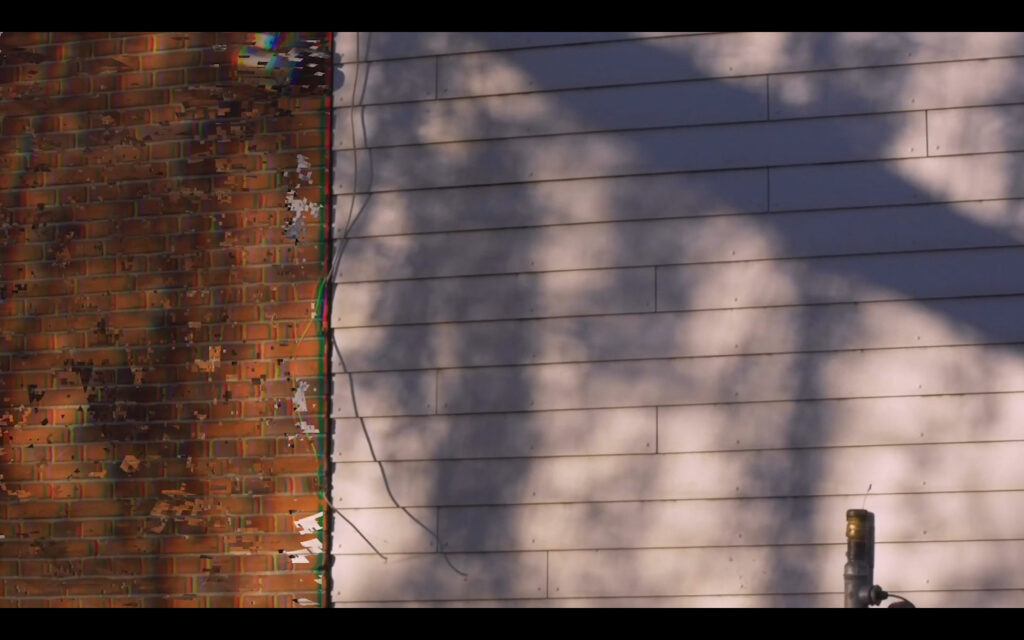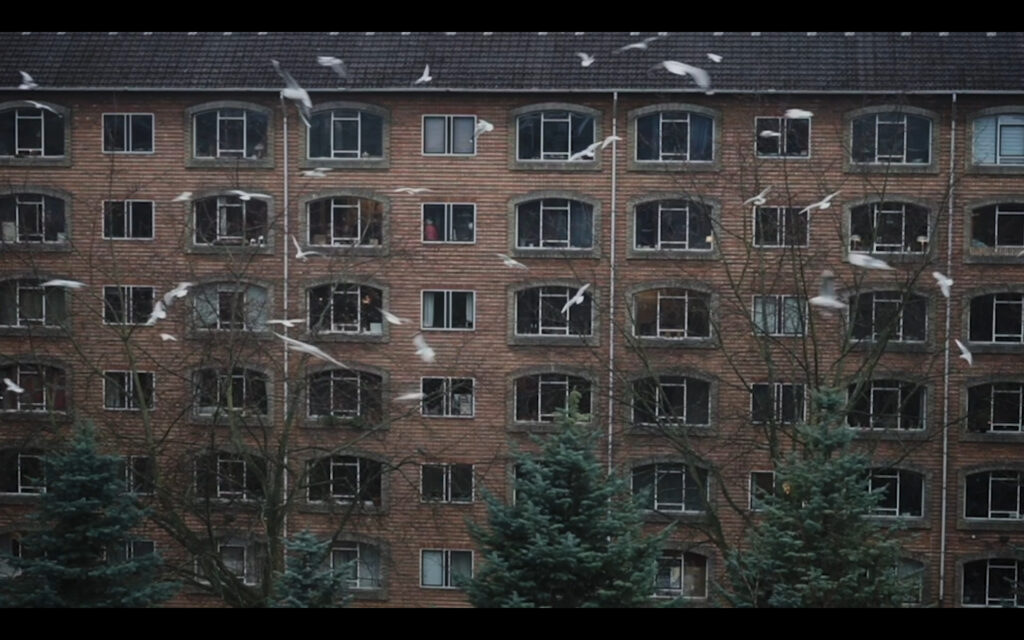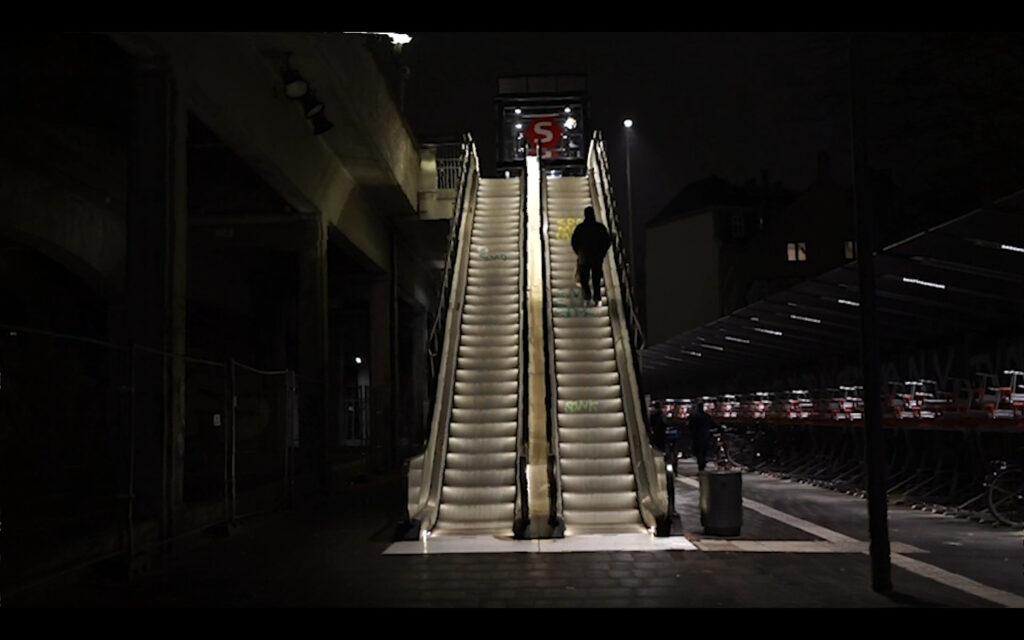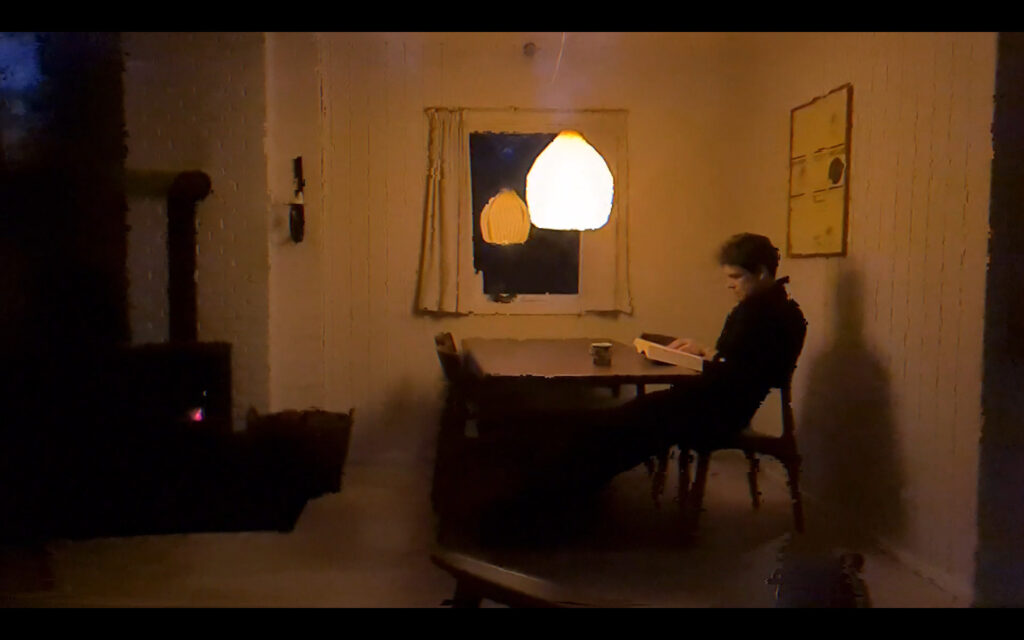The COVID-19 pandemic has brought the world into a state of despair. Not since the Second World War have so many people experienced trauma simultaneously.1 We are in a double situation—on the one hand, in despair, seeking empathy for our struggles, and on the other hand, guided by desires to overcome or confront the conforming refrains and restrictions of isolation. Affective states seem to govern both sides of the situation. As isolation breeds dreaming, restlessness, loneliness, haziness, or meditation, our surroundings become generative, morphing, leaking, transforming. The pre-pandemic places of attention now seem abandoned and quiet, but they also become places of bewilderment, generating a new sense of hope and despair.
As Donna Haraway writes, “It matters what stories make worlds, what worlds make stories.”2 This essay attempts to grasp and explore how inner stories and imagery transition into new worlds of lived spaces. The essay takes a departure from exercises in monstrous collective writing and video-making, in which we have explored our experience of the pandemic through speculative fabulations and imaginaries. In monstrous, we mean a hybrid of voices, a collective exercise as an odyssey of loose goals, ideas, fears, and wonders of the pandemic. Our collective and poetic writing has been sprinkled throughout the essay in sequences while the mosaic film work is made of the frayed edges and affective states of everyday scenarios, connecting the affects of the pandemic with the aesthetics of discontinuity and disembodiment.
As we engage in this essay—in writing, observing, and picturing subjects—our reflections unfold from a northwestern European perspective, being citizens of Denmark and Ireland, all of us rooted in the privileges of a welfare state. When reflecting on the city and life during the pandemic, we have our dominant experience set in an urban northwestern European context. We are aware that our experiences, elaborated in this essay, are personal explorations in the context of pandemics throughout history, and that they come from an overall privileged European position. We do not attempt to capture or search for a shared reality or experience, or aim to represent or reinsert specific perspectives, positions, or beliefs. Rather, this essay is a search in co-creation as an affective and aesthetic discipline to engage, process, and rearrange experienced moments of hope, despair, and bewilderment relating to the pandemic. We do not want to break free, disrupt, chase, or stay with these moments, but tremble with them. We situate them loosely within our theoretical backgrounds of visual culture, performance studies, affect studies, and urban studies. We have collaborated on arts-based practices for several years, developing artistic methods on approaching issues such as migration, borders, identity, and the climate crisis.

Pandemic Bewilderment
Still falling. Today. Still falling. From the repetitive orders and norms, repeating again and again. Still falling. Falling from the hard edges of what we have accomplished.
Spilling words, images, speculations all over the place. Words and gazes leaking from our living rooms. Your voice trembles for a moment. Words and images leaking from the concrete desserts of the city, from the rooftops of our discontent. On the floor life, trying to close my eyes of stones, my dream faces these weird friends from other cities. Doves coming from my chest, rumours!
We are being reworked, rewilded, and destabilized by an invisible submicroscopic infectious agent. As living bodies during a global pandemic, our experiences, daily lives, and the choreographies we perform are dramatically unstable. As Bayo Akomolafe writes, “Every virus in its unfolding mattering and mutability is the creation of new worlds; every jot and tittle come with their own universes. Viruses in themselves resist coherence and categorization; there isn’t a stable group we can refer to.”3 Such agents are tilting bodies. We are interested in the body’s various affective states and what a body can do in the time of the pandemic. Following Spinoza, we understand affect as the mutual and relational capacity of a body to affect and to be affected.4 Since COVID-19 spread, we have become aware that being affected has increasingly become an everyday experience: being affected by figures, social distancing, death, discrimination, and vitalist bodies; affected by our despair and desire, our new pathways and bewilderment, what Spinoza calls sad affects, affects which decrease the body’s capacity to act. However, sad and intensive affects also produce imagery, worlds, and words, potentially carrying repressed thoughts to the forefront.
The pandemic is bewildering, not only to our everyday life but also to our capacity and manner of imagining. Our bodies have been settled and restrained, and we are brought into inhabiting new daily routines, patterns of encountering, greeting, feeling, and (dis)connecting. The pandemic state has disciplined us and opened new priorities, capacities, choreographies, and limits. In other ways, it has left us in extreme disorientation and within a new wild disorder of our lives. The pandemic body is like a wild body, conflicted between new modes of inner and outer fantasies, orders and social control. Following Jack Halberstam and Tavia Nyong’o, to be wild “is to be beside oneself, to be internally incoherent, to be driven by forces seen and unseen, to hear in voices, and to speak in tongues”5 Such wild bodies conflict with the modern western narratives, stories, and everyday landscapes. Hence, the bewildered body experiences glitches in the former well-known urban landscape; it sees birds emerging in disembodied patterns, it imagines dark creatures entering into the twilight zone of what we have accomplished. It is as if we, in our bewilderment, distance ourselves from the categories within “human.” We observe how our surrounding landscapes are touched with an untamed and yet unseen vibrancy. Is something else emerging? Our life before the pandemic is now an echo or an aftershock, an internal image with frayed edges. We can listen to the news and the promises of returning to normal, but we cannot stay with such an image. Furthermore, what “normal” is the news referring to anyway and for whom?
We know that we need to rethink the pandemic and its potentials, rather than rethinking the normal, to break through it.6 In a similar vein, noted by Audrey Lorde, “The master’s tools will never dismantle the master’s house.”7 Hence, we need to develop other tools and collective ways of shaping and living out our desires and inhabiting our despair outside the logics and constraints of the normal. Live in the ruins of former worlds, previous times, visions, and dreams of the pre-pandemic, which we now have to dismantle, to enter our current conditions.

The Pandemic City
Still falling. Falling into broken flowers. No good internet connection and it is Corona time. Instead I’m attaching myself to the city of ruins.
The city, already a ruin.
The city, already a ruin. A wonder.
The city, already a ruin. A wonder. Drift away on my take-away.
Buildings leaking into the sky like lazy watercolors in slow motion.
Bring it home. Pandemic encounters on my kitchen floor. Hard concrete and dirty dishes.
During the pandemic crisis, the city and its social choreographies of distance and closeness are changing radically. The pre-pandemic city was, among other things, an interface for social encounters, gatherings, and physical presence. The city was host to festivals, concerts, sports events, demonstrations, markets, shopping malls, etc. Desires and hopes were released and explored in whichever form (commercial, sexual, radical, caring, restless). However, the pandemic city is a ruin of these sociocultural matters, and we have become forced to face each other in new ways and through new mediums and activities. Through the loss of public practice, we have been disoriented in how we face each other, how we face ourselves and how we become through mutual public appearance, gestures, and potentials.
These new orientations have made us encounter our disembodied selves and the hegemonies of society on a structural level. We encounter despair because we do not know how to move, how to relate, how to approach one another. It is as if drifting becomes the preferred mode of being in the city. Moreover, how can we understand the city without understanding how we bring our solitude and despair into the public? The city is an external social interface for our lives and relates to our inner mental landscapes, which we bring into the public. Architect Aldo Rossi once stated that the city is the locus of collective memory. We must add that while the public might be a shared space, it is not shared equally, as our cities are predominantly built and governed on the historical basis and ideals of patriarchal structures and mythologies of whiteness. Hence, the city is a shared space, yet it is shared unequally and a catalyst for growing social, cultural, and economic injustice and struggle, new global movements fighting colonial hierarchies, racism, sexism, and patriarchy—not to mention the city as a generator of climate change, overconsumption, and natural catastrophes, where effects are unequally distributed. So what we might experience as glittering shopping malls merely hide another layer of a consumer production of endless short pleasures, overconsumption, pollution, and massive waste production, and thus ruination and a world falling apart. As Bruno Latour states, we are all refugees now, as the foundation for life is slipping away from us.8 Cities are broken, and sharing affective states in public means sharing experiences of what is already broken.
While the home breeds and feeds subordinate desires, the city is the scene in which desires are momentarily shared from a distance. Our affective states, whether of despair or desire, are like viruses that spread. Viruses are leaking into the public. Like a virus shared and distributed through gazes, distances, proximities, movements, and expectations. The pandemic home, on the contrary, has become a multi-functional space, a workplace, a fighting ground, a breeding place for our desires, hopes, meditations, and fears. The home has, in many ways, replaced the public space with its multiple functions. It has also become the place for interface dialogues. Strange conversations often dominated by glitches and repetitively failed exchanges that keep returning as refrains of our devastation—“Can anybody hear me? Can you see me?” People try to pay attention, to be present, but the interface inserts time lapses, further distances, awkwardness, and disembodiment. We cannot overcome despair through such interfaces constructed from capitalist technologies. The refrains of social distance—“Can you hear me? Can you see me? Is anybody able to face my despair?”—do not only stick to the cruel fact of the inhuman technologies at hand but are also situations in which our despair leaks into more “junk-spaces”9—Zoom, Skype, Google Hangout, Teams, Messenger—that we cling to and nourish while simultaneously detesting them as they lack sensibility and touch. The intriguing promise of the interface is one of immediacy and closeness. However, what we get in return are uncanny unfoldings, and what we face is the distorted and haunting image of technoscientific ruination.
Let us return to the city. Halberstam and Nyong’o write, “We live in wild times; we bear witness to wild and ruinous places”10 Is it so that the city has become a ruin, not because of social distancing, but because we still expect it to be the shared space for our dreams? Do we dare to think the city and urban communities away from the current ruinous state and into other ways of being together? Furthermore, how do we inhabit this uncertainty together? While we long to be able to travel, meet people, attend events, it could be possible to inhabit the urban ruin as an opportunity to break the bonds of capitalist notions of desire. Perhaps as Rebecca Solnit proposes, it has the capacity to experience desire as a sensation worthy in and of itself, without releasing it through the conquering of the object desired: “We treat desire as a problem to be solved, address what desire is for and focus on that something and how to acquire it rather than on the nature and the sensation of desire.”11 Could the city become a place for desiring otherwise?
Hope and Desire
Subaltern algorithms in my body – shining, shining brighter.
Subaltern algorithms on my screen – they want you to buy and fuck.
Showered in the blue light of an empty chat-room
Bent out of shape from society pliers and love songs.
Forced ejaculation by the smiley on your screen.
We are guided by desires seeking to overcome or confront the conforming refrains and restrictions of isolation while at the same time speculating through new visual sensibilities and affects of everyday routines and spaces. In the pandemic state, spaces and places morph, leak, transform. They open up to other worlds and become places of desire and despair. The same can be said about our desires that leak and spillover in unbearable and contradictory situations. According to Lauren Gail Berlant, desire can easily sustain a “circuit of optimism and disappointment.”12 In such never-ending circuits and inclinations towards the good life, the subject both engages and loses herself. While attending optimistically to the political or the object of desire, she wears herself out, loses herself, and her relation to the world.

These affective circuits relating to desire are furthermore closely related to augmenting or diminishing capacities of a body. As if all the contradictions in desire hold within them an immense force for destruction and of life-building capacities. Does this in-betweenness of bodily desires hold a promise beyond a “cruel optimism”?13
Apart from creating jealousy, threat, or moral superiority, what might it do to people to reveal to themselves and each other that their particular desires are unbearable in their contradictions, unknown in their potential contours, and yet demand reliable and confirming recognitions? How might it become bearable to face the ways visceral responses combine convention and something else, perhaps inarticulate or illegitimate desires? What does it mean that, unreliable in desires, we nonetheless demand the other to be perfectly attuned to what’s out of tune?14
The visceral responses, our imaginations combine convention and something else, and something else is exactly what is of interest. In our desire for others and our attunement to compassionate relations beyond our current situation we face an in-betweenness that is affective and might hold a potentiality. In a Deleuzian and Spinozist understanding of affect, sad affects decrease a body’s potential to act. However, to be affected is both the potential in suffering and acting from this suffering. Affective powers both come from the outside, and are acted upon through embodiments from the inside. Deleuze writes, “Every existing mode is thus inevitably affected by modes external to it, and undergoes changes that are not explained by its own nature alone.”15 Is it so that exactly the capacity of a body to alternate between and learn from affective states of despair, desire and depression, actually broadens a body’s capacity to act? Berlant has noted that when you attach and engage, you become something else—you lose your ground. Could it be that the oscillation between affective states and the capacity to dwell in both sad and joyous affects is what can bring subjectivities into a more holistic and sustained existence? Capitalist culture promises excitement, quick relief, and joy in every product on the market. It also upholds a state of non-attachment and non-engagement, never letting you lose your ground. Academia promises new perspectives and breathtaking results, and technology promises bright technoscientific solutions to every damage we have done to the earth. All these quick fixes, solutions and joyful experiences accelerate. They make us sick with the promises of positive affects and problem-solving effects. They tell us our desires will come true if we just believe.
How can we leave those objects of desire and replace them with collective hope? By bringing our affective states of despair into the world and holding the crisis together, we believe we can lose the objects of desire by not reproducing norms and habits. Affective states of despair are not as the melodrama of the news and the binary media narrations of good and evil. Rather bewilderment opens towards breaking this bond with norms and the hegemonies of the life we once knew. Hence, let us return to a state of despair, but let us do it collectively. We try to visit despair without harboring it but instead allowing it to make us see the crisis we are in as a way of unlearning, to truly sense this crisis we are in and hence break down the objects of desire to let other worlds and ways of being together emerge. In this regard, dissociation with the life we knew does become affirmative.
Undercurrent Imaginations
Deep mapping in my dreams.
When hope is lost, time is our punishment.
Sometimes, we think that we can hear the sound of all the worries that are felt in the world, an ocean of worries uniting us, when we close our eyes and let go.
Undercurrents of imagining otherwise
We know from Berlant how desire and hope are related.16 Furthermore, that compassion easily leaks into despair. That despair is losing and fragmenting the object of desire and makes us lose the connections to our world. From the pandemic situations, we know how easily our desires leak into situations of despair and loss. Let us dwell for a moment in despair. Let us get deep into our bewilderment. Because now loneliness is awake twenty-four hours a day and the sounds and movements of despair hang in the air. Distance inhaled through every breath. Can we ever breathe again? Do we dare to exhale? Affective states are movements of breathing and inhabiting bewilderment for a while.
Affective despair—loneliness, fear, disillusion—may be, at the same time, imaginative reservoirs. If we dive into these undercurrents, could a more connected and calm existence be found? And more importantly, who would even have the resources, social safety net, or privilege to tap into such a state while still being able to escape it when the time comes? Tasting the notion of an inhabiting of bewilderment is genuinely a privileged place to be.
As noted by Rosi Braidotti, we are all in this together. Yet, we are not one and the same—“For many indigenous people on earth, epidemics, dispossession, and environmental devastations were the mark of the colonial conquests and of the Europeans’ appropriation and destruction of First Nations cultures. Catastrophes on this scale are, for many people on earth, an everyday reality—whether we think of climate change, intergenerational transmission, or public health issues. Europeans have a lot to answer for.”17 Rosi Braidotti calls for a lucidity relating to the affects involved in our current predicament and that we need to relativize them according to our own situation. We are in this together, but we are not one and the same.
From our current state of bewilderment, hope, and despair, speculation and fabulations have grown into new affective and affirmative matters. The pandemic state may have granted us the rare possibility of turning our gaze inwards, through boredom, anxiety, or isolation, drawing on our affect and everyday experience, like drifting with the undercurrents, beyond shameful subjectivities, means, or measure. Strange or challenging as this might be, turning the gaze inwards is a privileged and safe place to take shelter during a pandemic.
In times where new heteronormative homes are built worldwide and marginalised people expelled, their homes demolished. In these times where algorithms drain and capitalise on our deepest desires and find the products perpetually emerging on our screens conveniently. In these times where Earth—forests, oceans, rivers, the air—is recklessly polluted and damaged. In these times, we seem to destroy the very foundations of our living, pulling many other species into oblivion. In these times of racial inequality. In these times of borders and fenced walls. These times are indeed out of joint. How, in these times, can we dwell and feel at home? How can we have a place of connectedness, intimacy, and community that reaches beyond borders and social hierarchies?

Is it time to open up the sensitivities of home and disembody ourselves from the homes we know? A home can be a refuge from despair——a place to hide away when everything comes tumbling down. However, it can also be a place for undercurrent imaginations of despair—a home breeding alternate futures. Ursula Le Guin describes how the home is not a specific place, inhabited by specific mothers, fathers, dogs, or husbands, but instead, it is imagined; it comes into being through imagination. A shared imagination of the undercurrents? “It is real, realer than any other place, but you can’t get to it unless your people show you how to imagine it—whoever your people are.”18 And our people are not necessarily our relatives, they may not even be alive, they could be words on a page, as Le Guin notes: “But they can guide you home. They are your human community.”19
The pandemic has changed the routines and capacity of the body, the home, and city, by forming new lines of order, discipline, togetherness, loss, and bewilderment, morphing and leaking into new worlds. New worlds of discontinuity and disembodiment, being together and being unequal. Thus, bringing our attention to see this pandemic is not only a view into the many cruel truths that are thriving in our world but a gateway leading to where we enter the next world. As Arundhati Roy notes, “Historically, pandemics have forced humans to break with the past and imagine their world anew. This one is no different. It is a portal, a gateway between one world and the next.”20 A portal to imagine otherwise our mentality, our society, and our environment. A starting point for this journey must be collective. Writing, filming, and creating worlds together is where we in this project have found hope. However, we also acknowledge that to become genuinely collective, creating and imagining new worlds together must happen across nation-states, social groups, and power hierarchies.
Notes
- Zanny M. Beddoes. “How to reduce the mental trauma of Covid-19,” The Economist, August 28, 2020, https://www.economist.com/leaders/2020/08/29/how-to-reduce-the-mental-trauma-of-covid-19. ↩
- Donna Haraway, Staying with the Trouble: Making Kin in the Chthulucene (Durham: Duke University Press, 2016), 12. ↩
- Bayo Akomolafe. “I, Coronavirus. Mother. Monster. Activist,” personal website, May 15, 2020, https://www.bayoakomolafe.net/post/i-coronavirus-mother-monster-activist. ↩
- Baruch Spinoza, Ethics (1678; repr., New York: Citadel Press, 1957); Gilles Deleuze, Spinoza: Practical Philosophy (San Francisco: City Lights Books, 1988). ↩
- Jack Halberstam, Tavia Nyong’o, “Introduction: Theory in the Wild,” South Atlantic Quarterly 117, no. 3 (2018): 454, https://doi.org/10.1215/00382876-6942081. ↩
- Jack Halberstam, “Wild Things: An Aesthetics of Bewilderment,” RIBOCA 2 Online series, Andrejsala, October 7, 2020, https://www.youtube.com/watch?v=Ia5CmrzTqw4&t=489s. ↩
- Audre Lorde, “The Master’s Tools Will Never Dismantle the Master’s House” in Sister Outsider: Essays and Speeches (1984; repr. Berkeley, CA: The Crossing Press, 2007). ↩
- Bruno Latour, Où atterir? Comment s’orienter en politique (Paris: La découverte, 2017). ↩
- Rem Koolhaas, “Junkspace,” October 100 (Spring 2002): 175–90, http://www.jstor.org/stable/779098. ↩
- Halberstam and Nyong’o. “Introduction,” 454. ↩
- Rebecca Solnit, A Field Guide to Getting Lost (Edinburgh: Canongate, 2017), 32. ↩
- Lauren Gail Berlant. Cruel Optimism (Durham: Duke University Press, 2011), 27. ↩
- Berlant, Cruel Optimism. ↩
- Lauren Gail Berlant. Desire/Love (Brooklyn, NY: punctum books, 2013), 111. ↩
- Gilles Deleuze, Expressionism in Philosophy: Spinoza (New York: Zone Books 1990), 219. ↩
- Berlant, Cruel Optimism; Berlant. Desire/Love. ↩
- Rosi Braidotti, “‘We’ Are In This Together, But We Are Not One and the Same,” Bioethical Inquiry 17 (2020), https://doi.org/10.1007/s11673-020-10017-8. ↩
- Ursula Le Guin, “The Operating Instructions,” in Words Are My Matter—Writings About Life and Books (Easthampton, MA: Small Beer Press, 2016), 5. ↩
- Le Guin, Words Are My Matter, 5. ↩
- Arundhati Roy, “The Pandemic is a Portal,” Financial Times, April 3, 2020, https://www.ft.com/content/10d8f5e8-74eb-11ea-95fe-fcd274e920ca. ↩